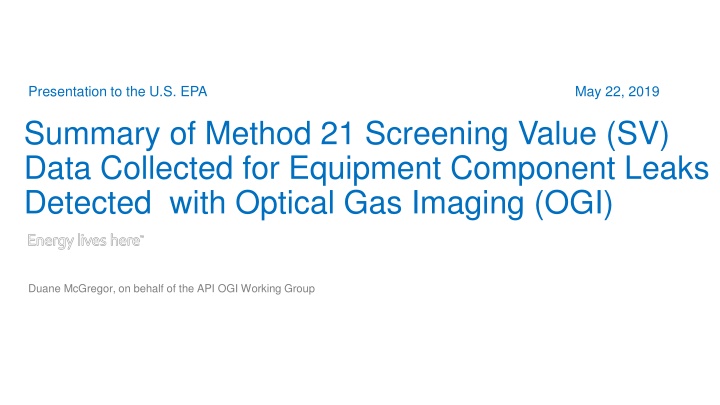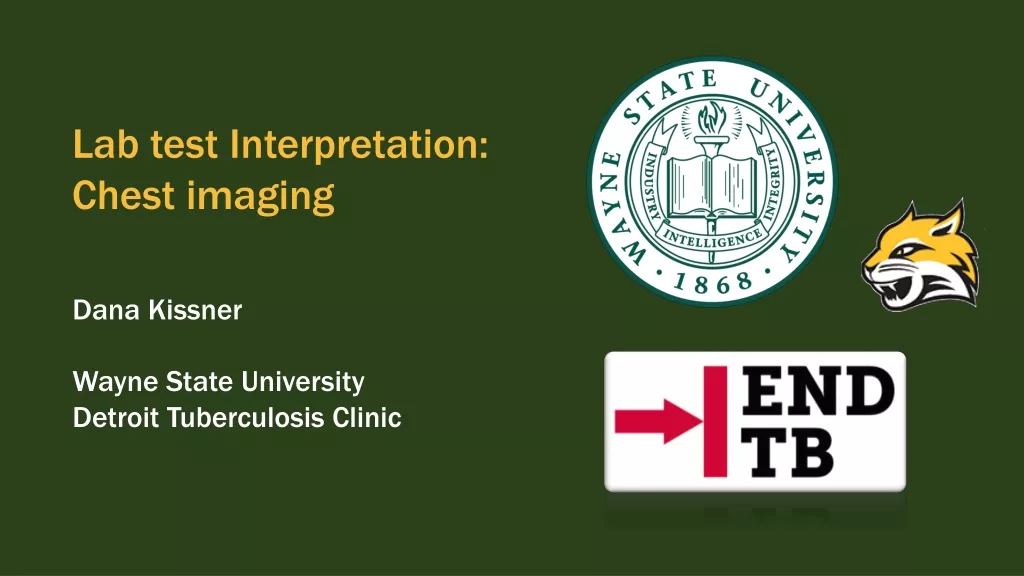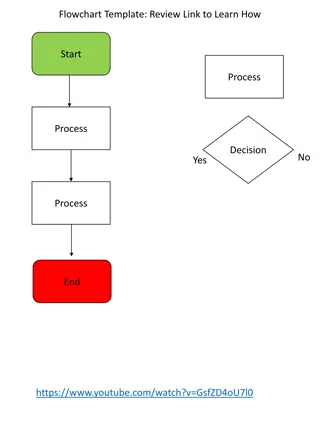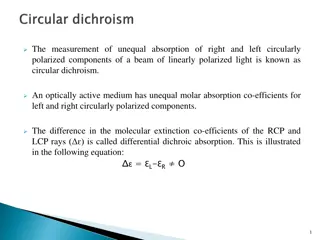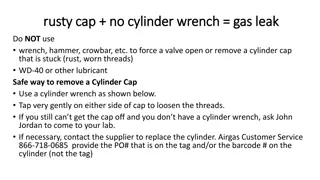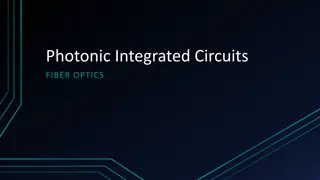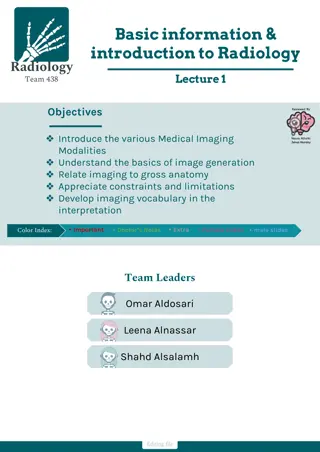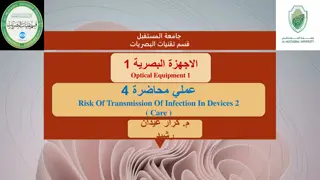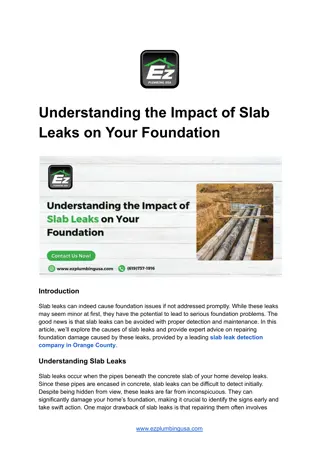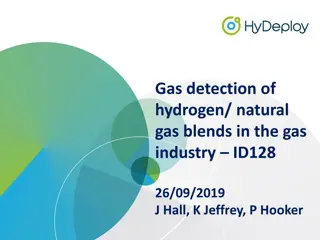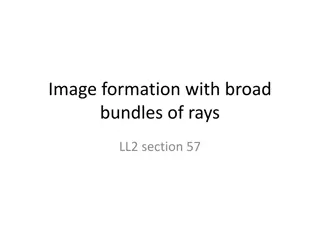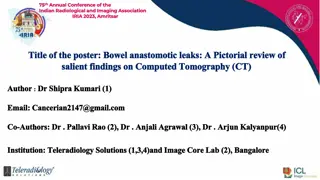Optical Gas Imaging for Equipment Component Leaks Screening
"Summary of SV data collected using Optical Gas Imaging (OGI) for detecting equipment component leaks and determining Method 21 Screening Values. Explore industry data showing the effectiveness of OGI in detecting leaks and setting reasonable detection thresholds. Key messages from refineries, chemical plants, and gas plants highlight the importance of OGI in reducing emissions and facilitating repairs."
Download Presentation

Please find below an Image/Link to download the presentation.
The content on the website is provided AS IS for your information and personal use only. It may not be sold, licensed, or shared on other websites without obtaining consent from the author.If you encounter any issues during the download, it is possible that the publisher has removed the file from their server.
You are allowed to download the files provided on this website for personal or commercial use, subject to the condition that they are used lawfully. All files are the property of their respective owners.
The content on the website is provided AS IS for your information and personal use only. It may not be sold, licensed, or shared on other websites without obtaining consent from the author.
E N D
Presentation Transcript
Presentation to the U.S. EPA May 22, 2019 Summary of Method 21 Screening Value (SV) Data Collected for Equipment Component Leaks Detected with Optical Gas Imaging (OGI) Duane McGregor, on behalf of the API OGI Working Group
Topics Objective / Key Messages Facilities Summary Facilities Survey Methodologies Summary of Industry Data Method 21 SV Distribution Equipment Component Distribution Discussion and Next Steps 2
Objectives / Key Messages Objectives Collect industry data showing that OGI (Optical Gas Imaging) can consistently detect equipment component leaks down to Method 21 SVs (screening values) of 10,000 ppm Leverage this data to show that a Method 21 SV of 10,000 ppm is a reasonable OGI detection threshold for evaluating emissions reduction equivalency Key Messages Refinery and Chemical Plant data show that most leaks detected with OGI are between SVs of 10,000 and 30,000 ppm, with some detections below 10,000 ppm Gas plant data show that 88% of leaks with M21 SVs >10,000 ppm were detected with OGI Gas plant data also show that many leaks with M21 SVs of 5000-10,000 ppm can be detected w/OGI Industry data show that assuming 10,000 ppm as the leak threshold for OGI is a reasonable basis for evaluating emissions reduction equivalency when using OGI vs. M21 for leak detection Connectors were >75% of leaks detected with OGI for the Refinery and the Chemical Plant Shows that regularly monitoring connectors with OGI will lead to an increase in repairs of components leaking at higher rates 3
Facilities Summary OGI/Method 21 data obtained from 1 Refinery, 1 Chemical Plant, and 2 Gas Plants Refinery: 1238 Components evaluated with M21 after OGI detection (2017-2019) Chemical Plant: 2736 Components evaluated with M21 after OGI detection (2016-2019) Gas Plant 1: 44 Components evaluated simultaneously with M21 and OGI (2017 & 2019) Gas Plant 2: 95 Components evaluated simultaneously with M21 and OGI (2017) Survey Methodology Refinery and Chemical Plant For these two facilities, OGI surveys were completed independent of Method 21 surveys. If OGI detected a leak then a Method 21 SV was obtained subsequently for that component. Repairs were completed on these components as required by regulation Survey Methodology Gas Plants For the Gas Plants, known leakers (recently found leaking or Delay-of-Repair components) were surveyed side-by-side with OGI and Method 21 Neither survey methodology specifically followed the draft survey protocol 4
Refinery Method 21 SVs: Frequency Distribution M21 SVs were measured after a leak was detected using an OGI camera (FLIR GF320) OGI camera regularly used for component leak monitoring Most of the OGI-detected leaks were found to have M21 SVs >10000 ppm Minimum detected M21 SV = 2291 ppm M21 SV distribution is as expected i.e., the number of leaks decrease as the M21 SV increases 6
Chemical Plant - M21 SVs: Frequency Distribution M21 SVs were measured after a leak was detected using an OGI camera (FLIR GF320) OGI camera regularly used for component leak monitoring Most of the OGI-detected leaks were found to have M21 SVs >10000 ppm Minimum detected M21 SV = 727 ppm M21 SV distribution is as expected Fewer leaks were detected at higher M21 SVs 7
Gas Plants - M21 SVs Summary (slide 1 of 2) OGI and Method 21 were simultaneously used to survey known leaking components Method 21 provided a SV for each component surveyed OGI technician indicated whether the known leak could be visualized Majority of components surveyed were valves (81 of 109 components where SV>500 ppm) 81 leaks detected with OGI 39 leaks detected with OGI had M21 SVs <10,000 ppm 88% of leaks with M21 SVs >10,000 ppm were detected with OGI 671 ppm = lowest M21 SV detected with OGI 8
Gas Plants - M21 SVs Summary (slide 2 of 2) Total No. Components Surveyed 139 No. Components with SV > 500 ppm 124 No. Components with SV > 5000 ppm 77 No. Components with SV > 10,000 ppm 48 Many leaks with SVs between 5,000 and 10,000 ppm were detected with OGI No. Leaks detected with OGI 81 %Comp OGI Detected w/ SV>10,000 ppm 88% 9
Refinery OGI Detection Component Distribution Refinery data show that connectors made up >75% of the leaks detected with OGI All connectors surveyed at the same frequency as other equipment components for multiple years at this Refinery These data show the potential emissions reduction benefit upon including connectors in an OGI-based LDAR program These data also show that it was reasonable to include connectors in the M21-OGI emissions reduction equivalency assessment (provided in an earlier API-EPA meeting) 10
Chemical Plant OGI Detection Component Distribution Chemical Plant data show that connectors were >75% of the leaks detected with OGI All connectors surveyed at the same frequency as other equipment components for multiple years at this Chemical Plant The OGI component detection distribution is similar to that for the refinery (previous slide) These data show the potential emissions reduction benefit upon including connectors in an OGI-based LDAR program These data also show that it was reasonable to include connectors in the M21-OGI emissions reduction equivalency assessment 11
